Ali Eid | Hassan Ibrahim
On the banks of a lake, which has now become a mere memory, small boats have carried the memories of vacationers for many unknown years, while the waters have receded to the point of vanishing. By the summer of 2024, the area transformed into a dried land that a farmer planted with seedlings of peppers and tomatoes.
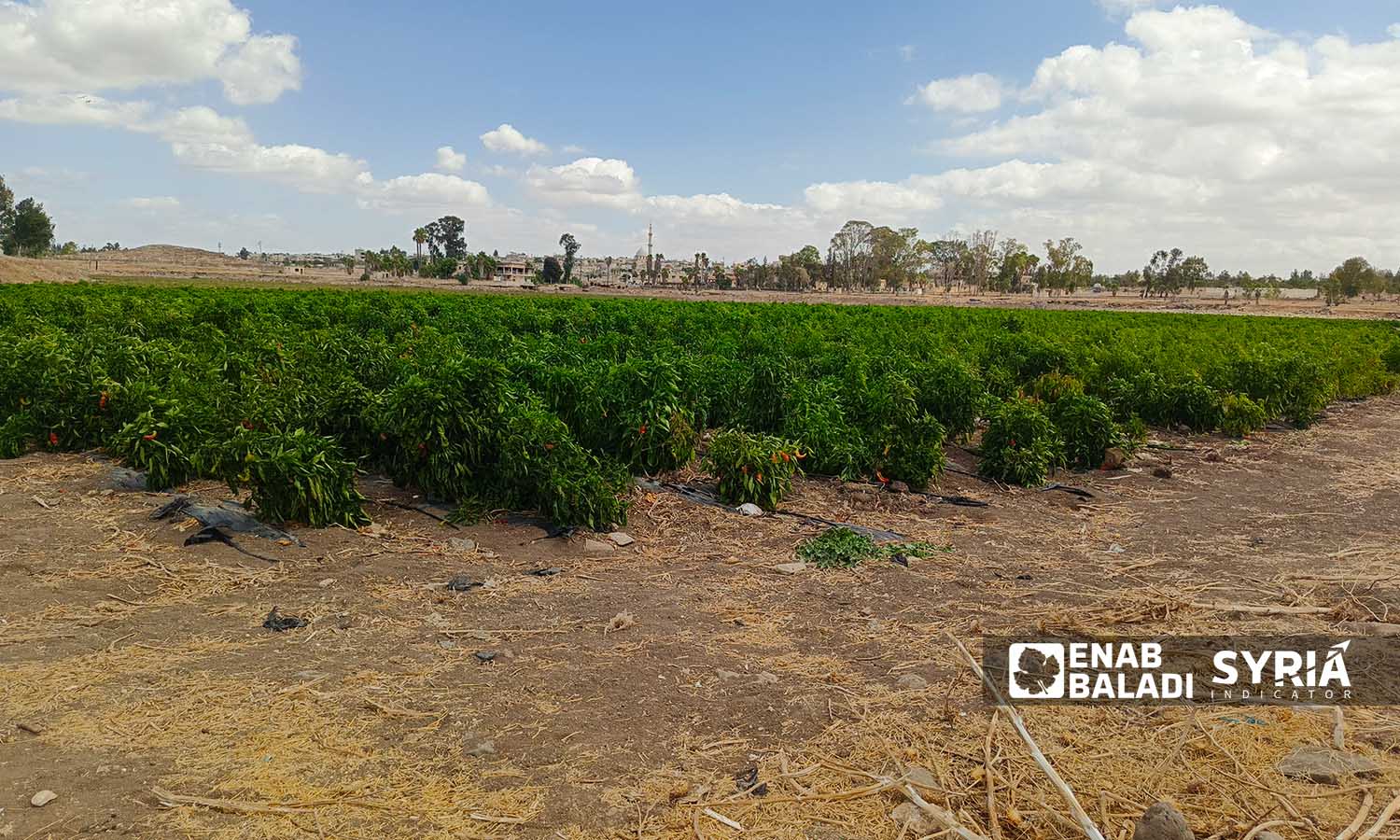
The bottom of Lake Muzayrib in the countryside of Daraa, which has now turned into a space cultivated with red pepper and eggplant seedlings – September 2024 (Exclusive for the investigation by Halim Muhammad)
The eucalyptus trees, weary from thirst, reveal what has happened to Lake Muzayrib in the western countryside of Daraa, as if they encapsulate the story. The face of life has changed here in the land of springs, so what about the rest of the regions in the governorate? Many say that migration is “inevitable” with the dual crisis of drought and insecurity.
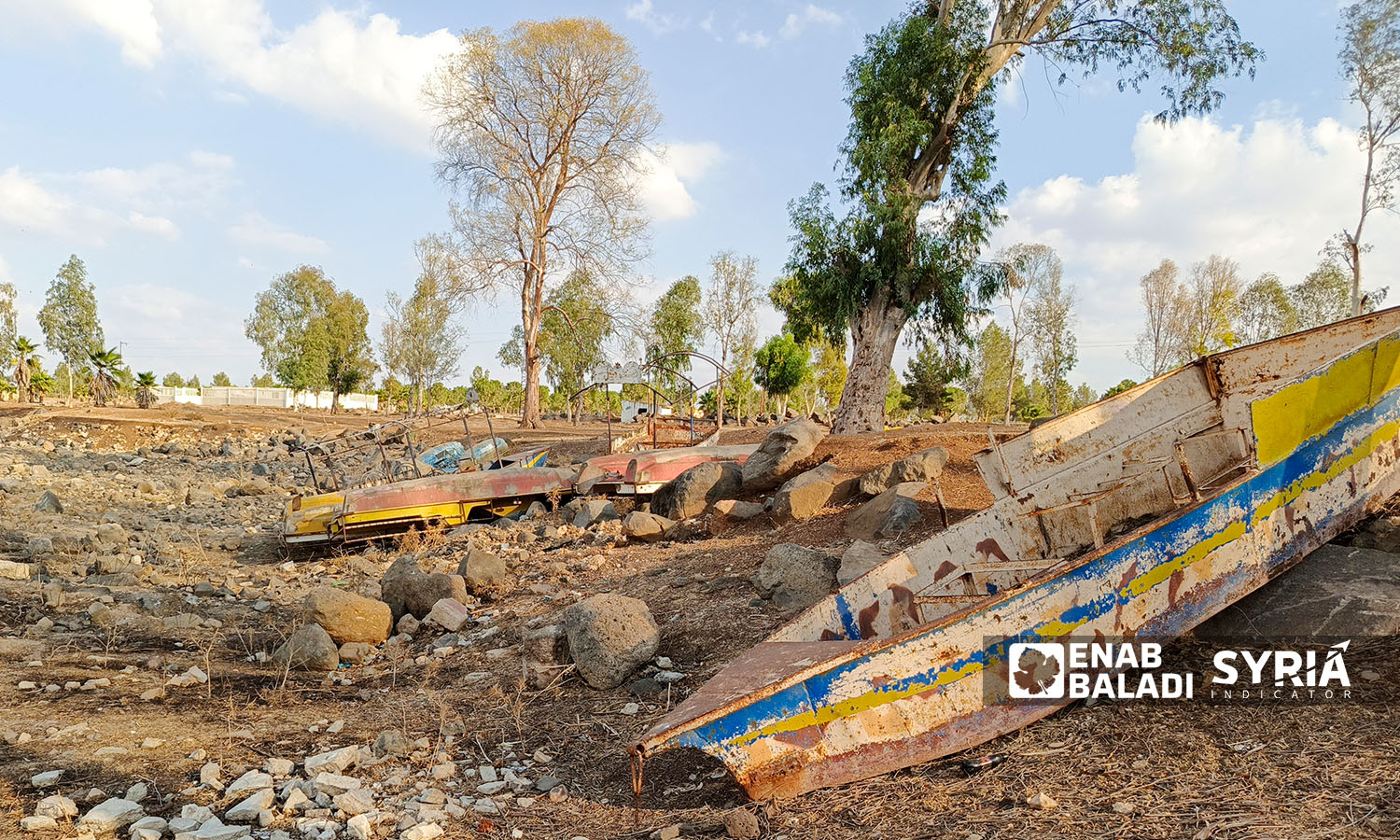
Abandoned boats on the shores of Lake Muzayrib in the countryside of Daraa – November 8, 2024 (Exclusive for the investigation by Halim Muhammad)
The war, which has burdened the country since 2011, and the depletion of thousands of random wells from water sources, have deepened the impact of the recent wave of drought and the decline in agriculture, which is the most important source of livelihood in Daraa, “the vegetable basket of Syria.” The government’s failure to find alternatives has exacerbated the situation.
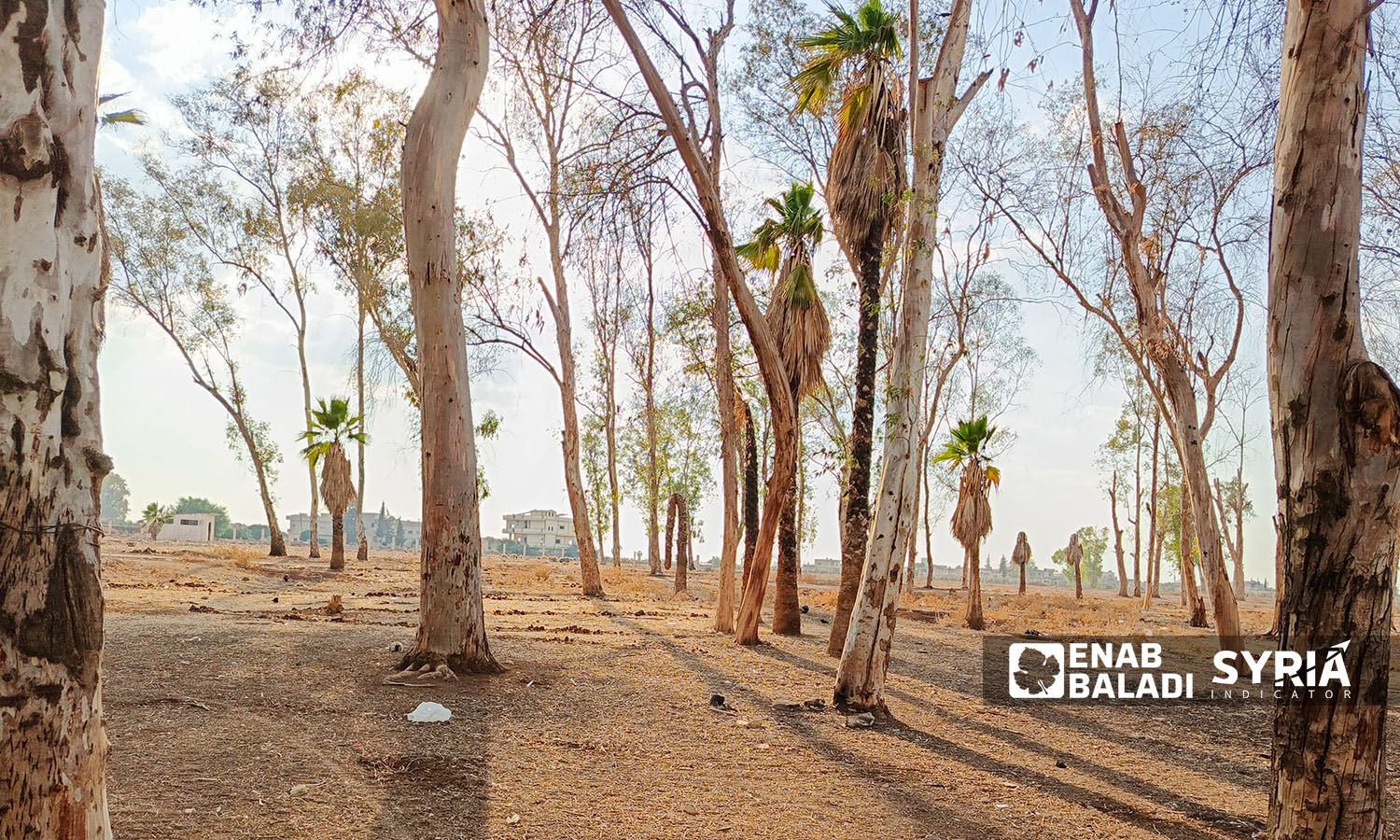
Eucalyptus trees withered around Lake Muzayrib in the western countryside of Daraa, November 8, 2024 (Exclusive for the investigation by Halim Muhammad)
Lake Muzayrib: Key features
Lake Muzayrib was the clearest indicator of the drought in Daraa, as its waters have diminished since 2017, eventually drying up completely by 2022, a fact corroborated by an investigation by Enab Baladi / Syria Indicator through satellite images.
This followed warnings about the depletion of the Yarmouk Basin, relied upon by the southern region, especially Daraa governorate, and four other water basins in Syria: Barada, al-Awaj, al-Assi, al-Sahoub, Tigris and Khabour, according to the Fanack website, which specializes in studying the water situation in the Middle East.
Lake Muzayrib is the largest water body in Daraa, supplying the towns of Muzayrib, Yadouda, and the neighborhoods of Daraa al-Balad and the Daraa suburb with drinking water, covering 18% of the needs of the neighboring As-Suwayda governorate.
The lake is located west of the town of Muzayrib, with an area of one square kilometer, measuring 500 meters in length and 250 meters in width.
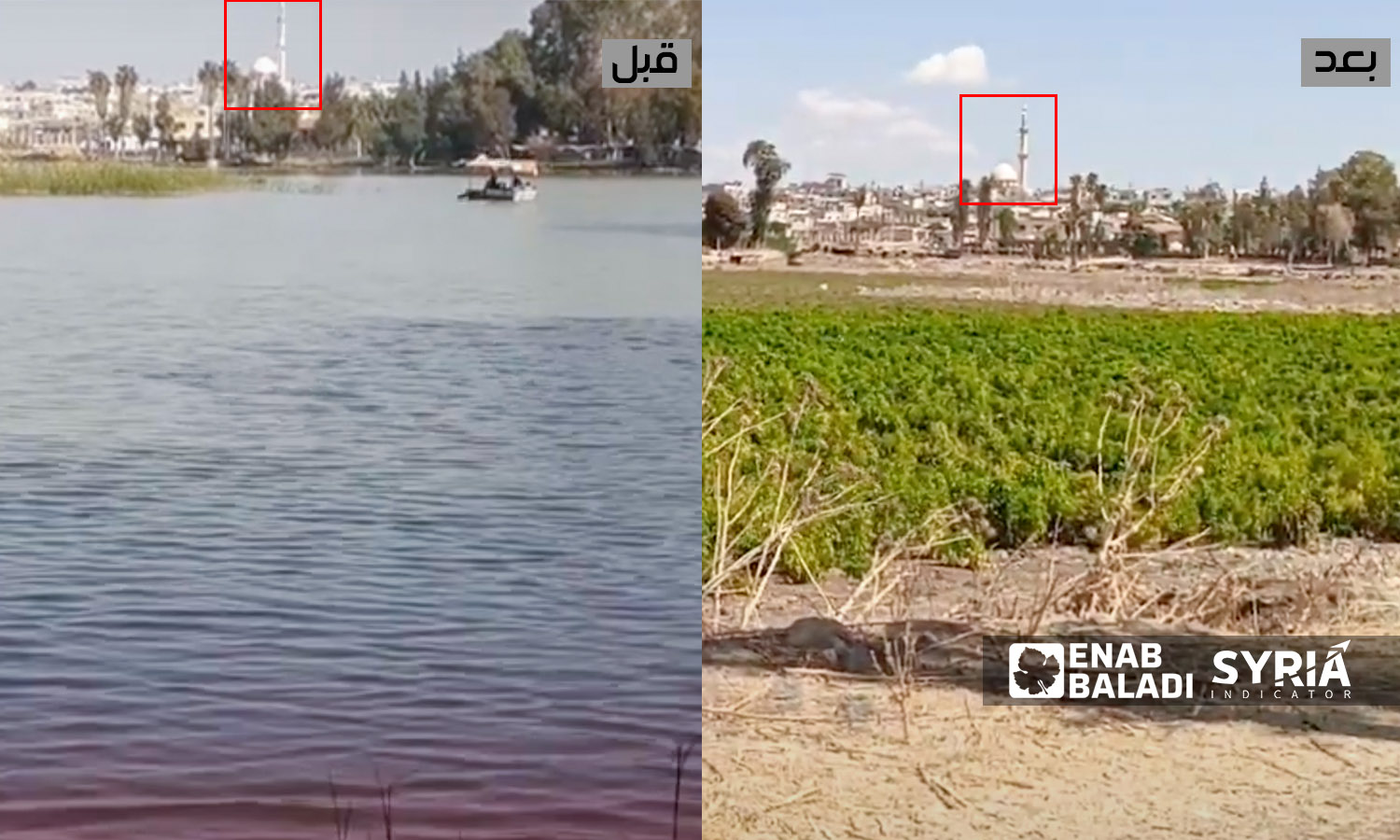
Lake Muzayrib before its drying in 2019 (left) and after its drying in 2024 (Exclusive for the investigation by Halim Muhammad)
In addition to Muzayrib, partial drought has struck the springs and lake of Zayzoun, which covered part of the region’s needs for drinking water and irrigation for agriculture via pumping engines.
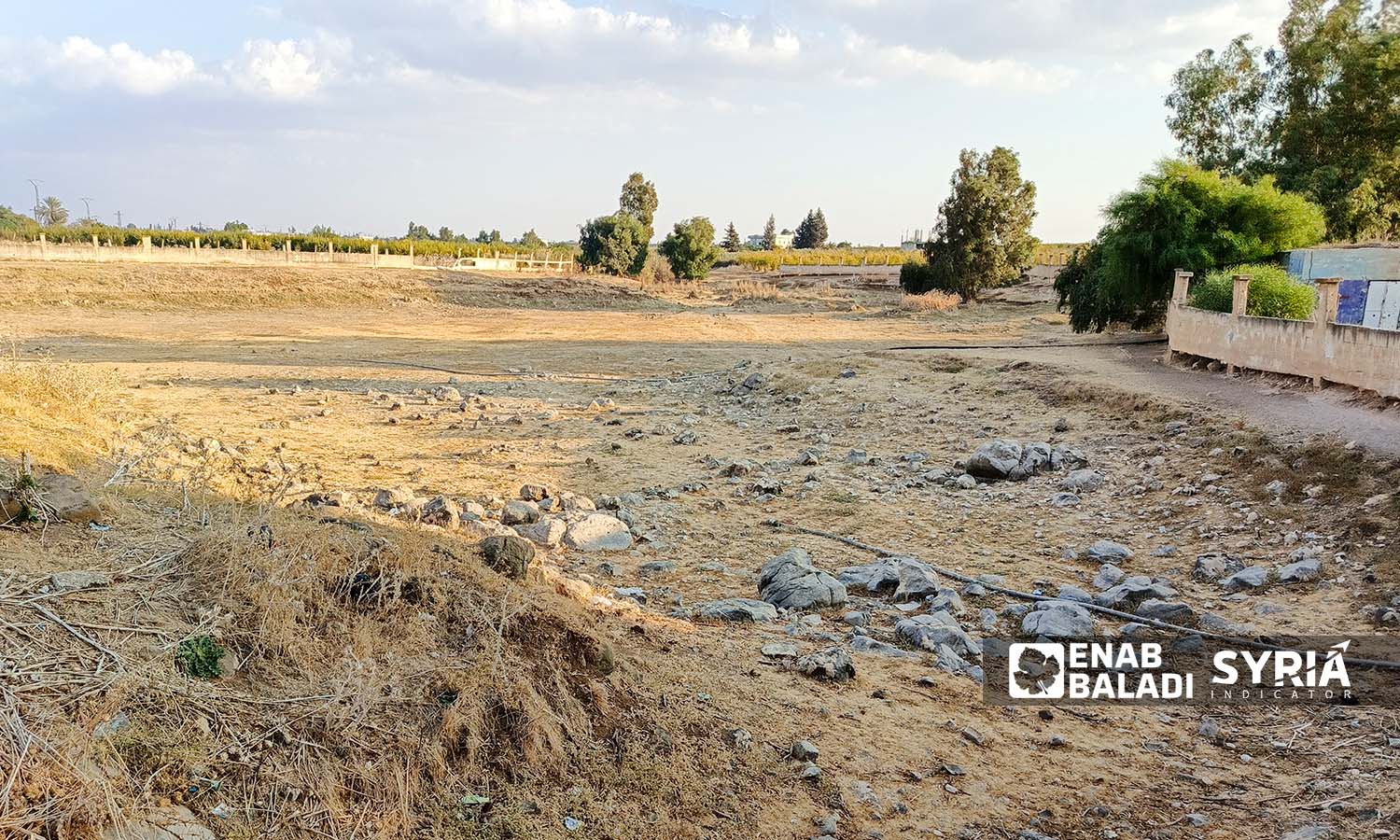
Lake Zayzoun (March 13, 2024) and after the drought (November 8, 2024) (Exclusive for the investigation by Halim Muhammad)
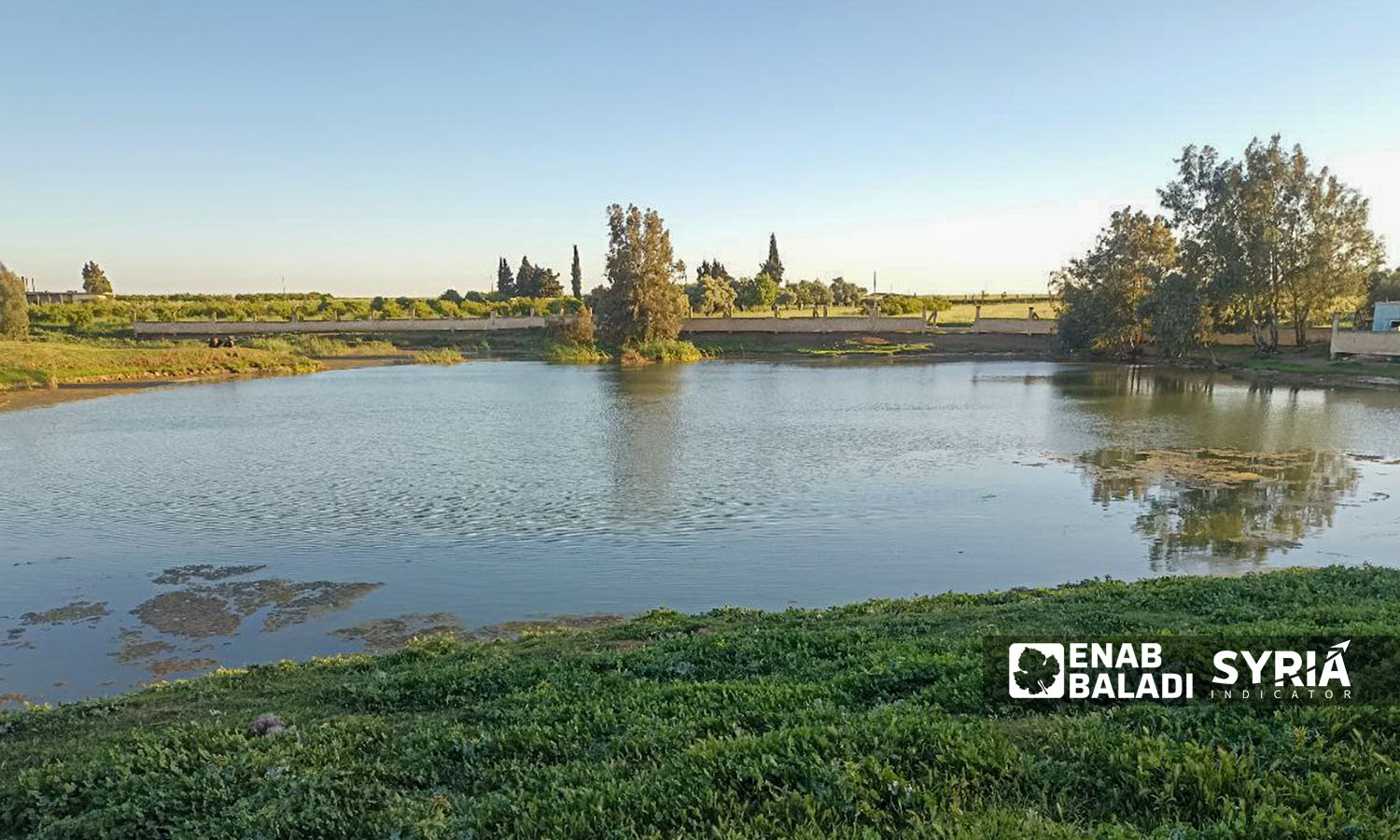
Lake Zayzoun (March 13, 2024) and after the drought (November 8, 2024) (Exclusive for the investigation by Halim Muhammad)
The picturesque waterfalls of Tel Shihab also dried up due to the complete drying of Oyoun al-Sakhina in the summer of 2023, which returned last winter but dried up again in the summer of 2024. The drought deprived over 15,000 people in the town of Tel Shihab on the Syrian-Jordanian border of drinking water.
Previously, in 2022, Ayn al-Abd dried up, which had supplied drinking water to approximately 200,000 people in the Jidour areas.
Fresh water was pumped from Ayn al-Abd through six high-capacity engines, with excess water for agricultural irrigation needs in the orchards of Tafas city and the villages of Ajami and Zayzoun.
According to government statements from 2008, the flow from Ayn al-Abd reached 280 liters per second.
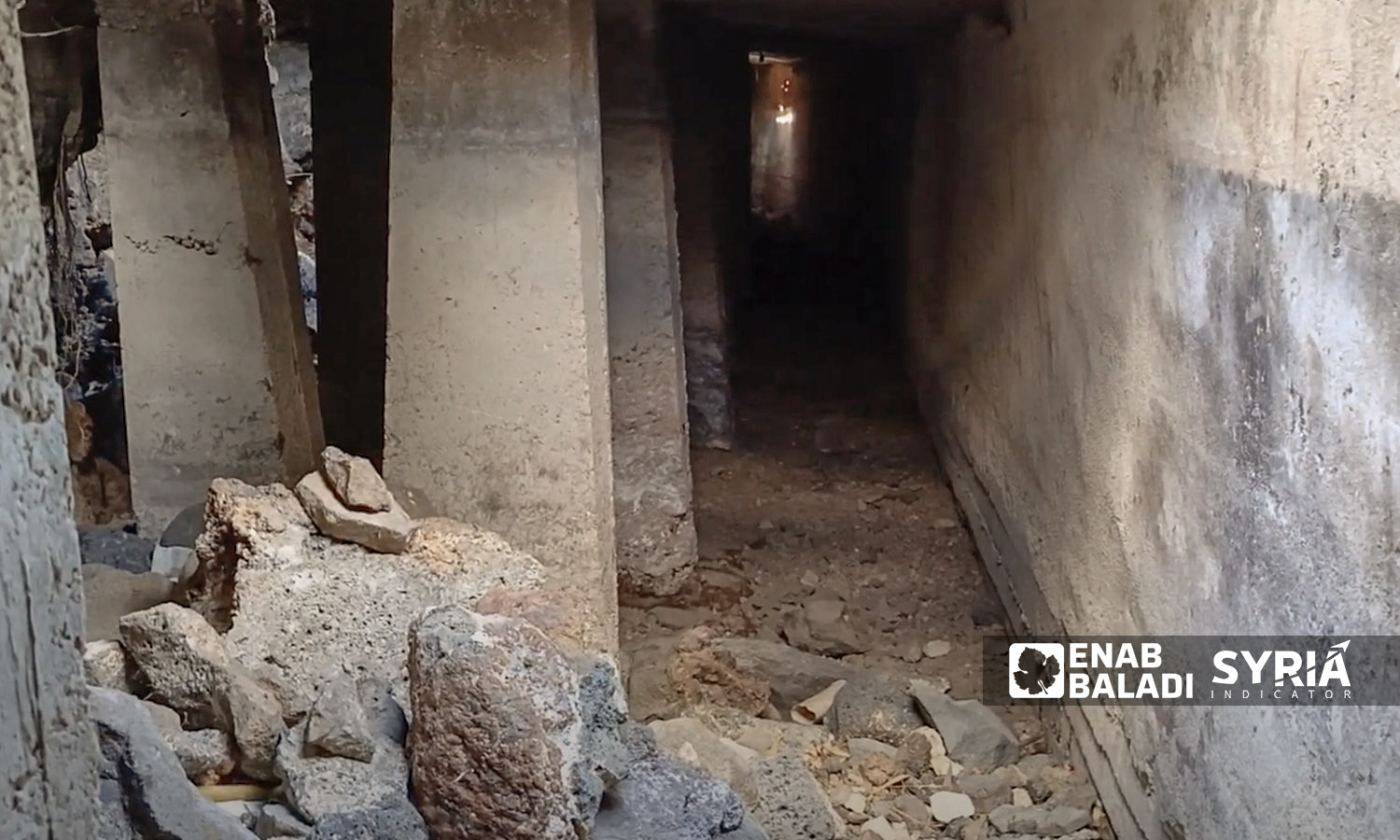
The depletion of water in a water cave in Ayn al-Abd, which used to supply about 200,000 people in the Jidour areas with drinking water – November 2024 (Exclusive for the investigation by Halim Muhammad)
Previous drought waves
Lake Muzayrib experienced a sharp decline in its water level before the recent wave, starting in the early 1990s, when its output decreased from 1,085 liters per second in 1990 to 206 liters per second in 2008, the year in which more than 25 springs in Daraa dried up.
The drying of the lakes and springs brings to mind previous drought waves that hit the region, including the drying of Ayn al-Basal springs in Muzayrib town in 1986, Ayn al-Siriyah in Sheikh Miskeen city in 1989, and Ayn Bandak in Ajami village in 1990, along with springs that used to burst forth in the orchards of the western countryside, some of which reached a flow rate of four inches.
Then, in 2004, Lake al-Ajami dried up, which was a water source used for irrigation, supplying the orchards of Zayzoun, al-Ajami, and Tafas, according to residents of the area encountered by the investigation team.
Thousands of random wells exacerbate drought
As drought extends over the geographical area of Daraa, drilling rigs operate non-stop to dig new wells or deepen existing ones, to the extent that some farmers are drilling more than one well within a narrow geographic area, which poses a greater risk to the groundwater.
Random well drilling is considered the primary cause of drought in Daraa, as the number of illegal wells reached 20,000 in 2024, compared to 8,000 wells before 2010, according to engineer Ali al-Buqairat, an expert in water resources and former head of pumping centers in the Yarmouk Basin, to the Enab Baladi / Syria Indicator team.
The Director of Water Resources in Daraa, Ahmed Mohsen, mentioned that residents of the region reported 4,000 illegal wells in the governorate during 2023 and up until the beginning of December of the same year, with a large number of random wells that their owners have not declared, which still poses a threat to the sources of the springs.
The official stated that these wells drain large amounts of water, saying, “We will face an impending water deficit that cannot be compensated.”
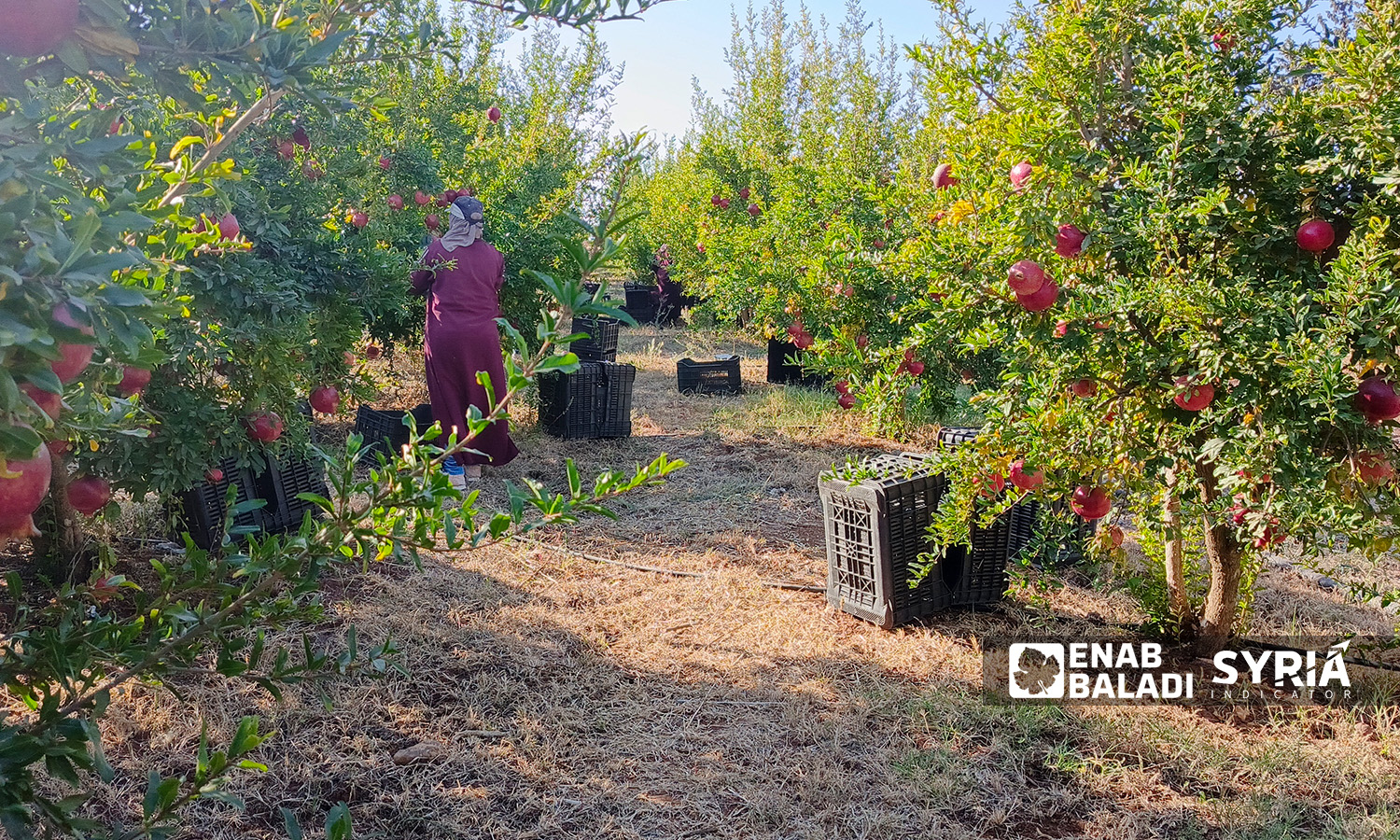
A girl actively harvesting pomegranate from one of the farms in the countryside of Daraa – November 2024 (Exclusive for the investigation by Halim Muhammad)
Engineer Ali al-Buqairat pointed out that drilling has affected the water-bearing pathways, with current drilling depths in the western countryside reaching up to 300 meters, which threatens the alteration of water veins’ pathways. The first water-bearing layer is located at a depth of less than 50 meters.
The investigation team asked some farmers about the depths they have reached to verify the impact of wells on groundwater, and farmer Anas al-Muhammad, a well owner, mentioned that he increased the depth of his well from 50 meters to 150 meters, “but to no avail,” as the well completely dried up in early summer 2024.
In the eastern countryside areas, several sources indicated that drilling mostly occurs at depths exceeding 400 meters and reaching up to 550 meters.
Three specialized engineers from different parts of the governorate mentioned that drilling thousands of random wells, whether within populated areas or surrounding agricultural lands, has caused destruction at the edges of the outflow water basins in most of Daraa, leading to water waste from these basins, subsequently reflecting a decrease in well output.
The engineers alerted about the dangers of drilling at the edges of the outflow basin, which leads to damage in the water-bearing area and water escaping from the basin, putting the area in a state of water deficit, and “leading to a humanitarian disaster in the region,” as described by one of them, engineer Ali al-Buqairat.
Daraa loses 3 million olive trees
In the years leading up to the protests of 2011, Daraa established itself as one of Syria’s provinces producing olives and fruits, with the number of olive trees estimated at about six million, planted over an area of 30,000 hectares in 2010.
After 2011, the number declined, reaching three million trees by 2023, and the area planted with olives shrank to about 22,901 hectares, according to Eng. Hanan al-Khayyat, head of the Fruit Trees Department at the Daraa Agriculture Directorate.
These figures reflect the deterioration and poor agricultural reality due to the ongoing drought, especially with olive crops, as olive trees are more drought-resistant than others, and can be watered twice during the summer, provided the land is plowed regularly to maintain soil moisture, according to engineer Khaled al-Hashish in an interview with Enab Baladi / Syria Indicator.
Other fruit trees have also fallen victim to the drought. Anas al-Mohammad, a farmer who owns 500 pomegranate trees in the western countryside of the province, has seen his trees wilting and yellowing due to water shortages.
He complains of a gradual decline in the volume of crops he produces over the past two years, coinciding with a drop in the groundwater from the well that irrigates his crops.
In 2020, the yield per dunam of al-Mohammad’s pomegranate crop reached four tons, but it fell to one and a half tons in 2023, and then to one ton in 2024.
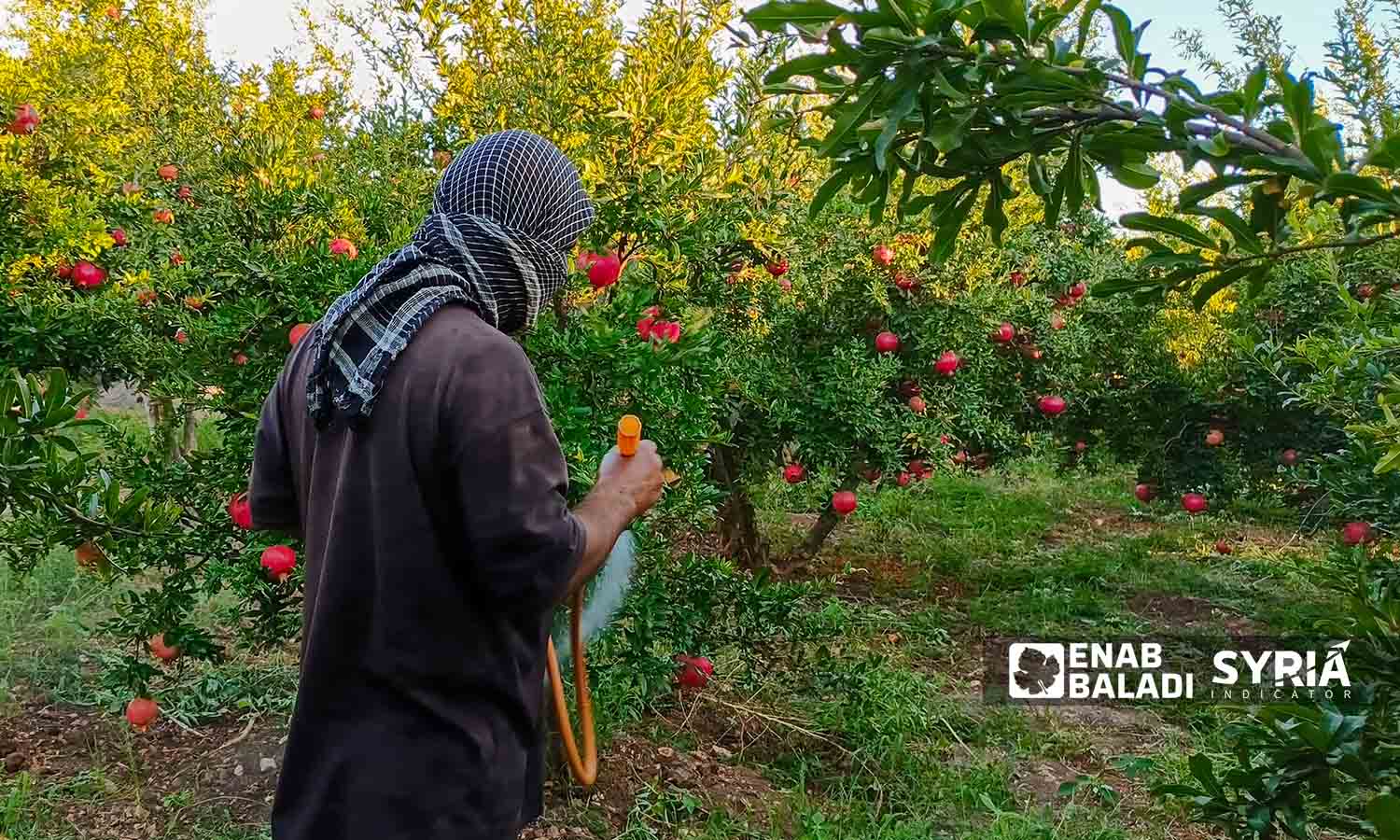
A farmer sprays pomegranate trees with pesticides – Rural Daraa – November 8, 2024 (Exclusive for the investigation by Halim Muhammad)
As for farmer Hussein from the town of Tel Shihab, he cut down most of the pomegranate trees that he cultivated over an area of 20 dunams after the water level in his well dropped from 40 cubic meters per hour two years ago to half that last year, resulting in a decline in his yield from 100 tons to just 30 tons.
Pomegranates require a thorough watering every 15 days, which led him to eliminate the trees, keeping only five dunams, as Hussein stated.
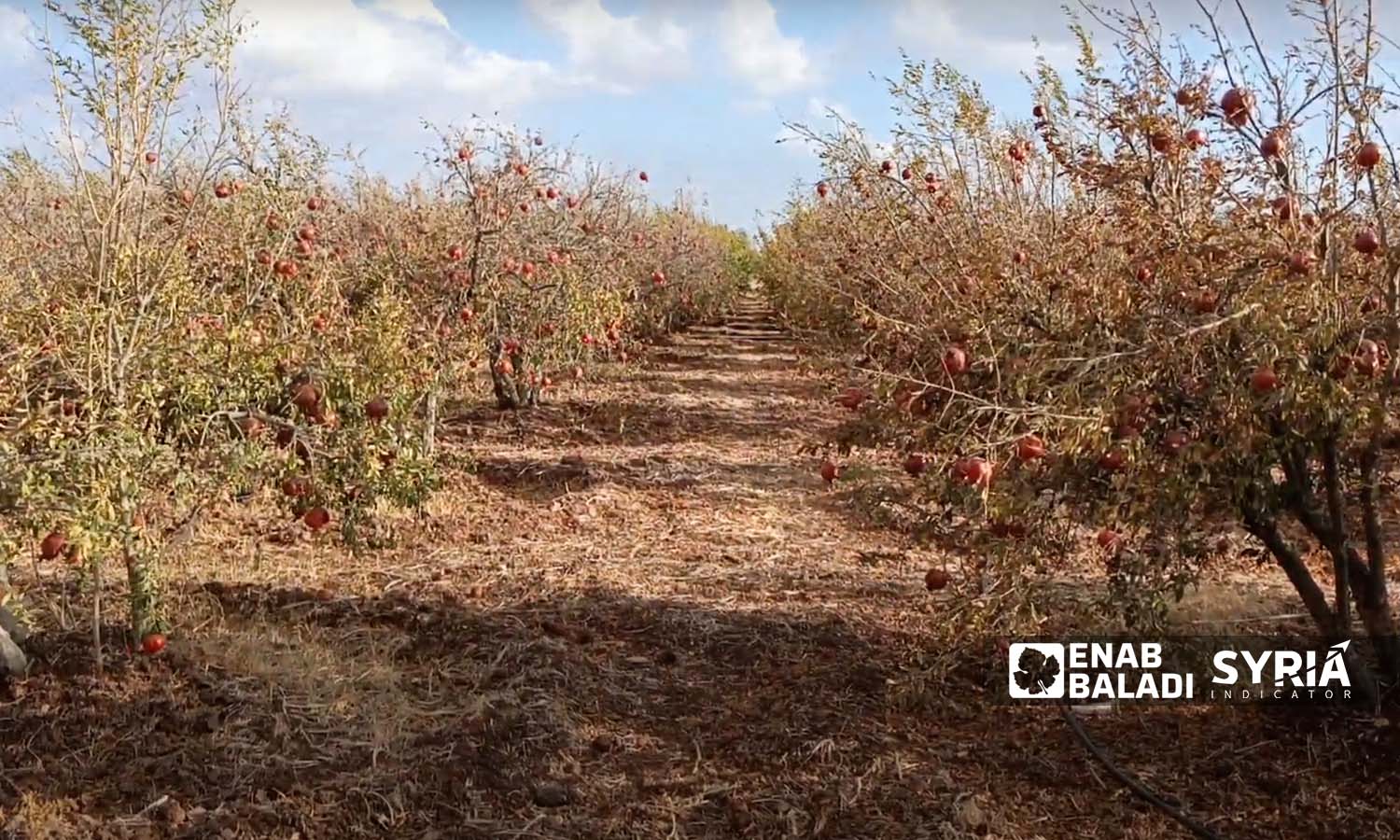
Withered pomegranate trees due to water scarcity and drought – Daraa countryside – November 8, 2024 (Exclusive for the investigation by Halim Muhammad)
Decline in vegetable and livestock production
The impact has not been limited to fruit trees but has extended to summer vegetables. The investigation team recorded a decline in the areas planted with vegetables in Daraa governorate over the past four years, reaching 2,110 hectares in 2024, while the area in 2020 was 2,658 hectares, reflecting a decrease of 540 hectares.
This year, Nour al-Din did not plant summer vegetables on the land he usually rents each year in the town of Zayzoun, despite relying on vegetable crop cultivation to secure income for his family.
Nour al-Din told the investigation team that the water level in the well he depended on for irrigation dropped in 2023, affecting his crop production, so he decided to forgo summer crop cultivation this year.
Like Nour al-Din, farmer Muhammad al-Akram lost his season of summer vegetables (eggplant and peppers) after the well he relied on for irrigation dried up, causing him a financial loss estimated at more than 30 million Syrian pounds (15,000 pounds equal one dollar).
Al-Akram did not expect his well to dry up completely, as the water level had dropped in August 2023, but its complete drying in July 2024 was surprising and early.
Following the drastic drought over the past two years, some farmers have turned to focusing on winter crops (lettuce, cauliflower, beans, peas, and grasses), as they consume less water, coinciding with a seasonal recovery of some groundwater levels, but these crops do not meet their needs, according to farmer Nour al-Din, who settled for parsley and coriander last winter.
Livestock farming has also been affected by the drought, which impacted grazing lands. The reliance on ready-made feed has become costly, leading many breeders to abandon much of this activity. This is the case for Muhammad, a 28-year-old from the village of Omariya in the western Daraa countryside, who sold three cows and several sheep after his well dried up, which provided drinking water for his home and livestock, now relying solely on water trucks.
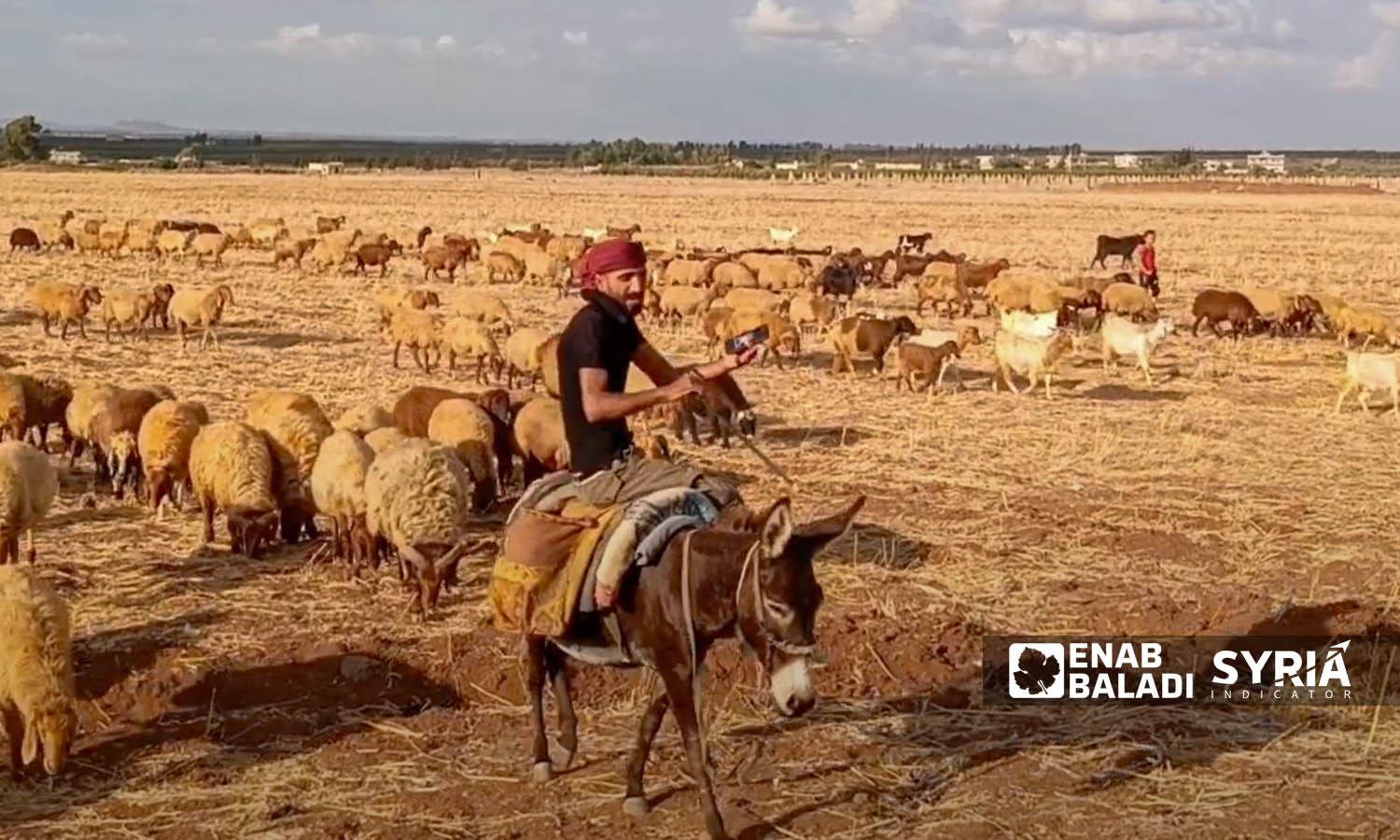
A shepherd with his flock of sheep and goats in western Daraa countryside – September 24, 2024 (Exclusive for the investigation by Halim Muhammad)
Muhammad’s livestock consumes about one cubic meter of water daily, which adds to the cost of milk production, which he considers unprofitable, given the high cost of feed. He buys one cubic meter of water for 30,000 Syrian pounds and one kilo of feed for about 5,800 pounds, while he sells one kilo of milk for 5,000 pounds, making it a “losing” process, as he describes it.
Migration… “An inevitable reality”
Drought is a second war faced by the residents who have stood firm in their cities and villages in the Daraa governorate, driving more people to migrate or plan for it, following the previous wave that began due to security conditions since March 2011. The depletion of water has disrupted the most important lifeline, which is agriculture.
Farmer Nour al-Din states that he did not plant his land this summer due to drought, and that winter agriculture does not provide for his family’s sustenance. Therefore, he has begun thinking about helping one of his sons travel to European countries via smuggling routes.
Security events have played a significant role in the displacement and migration of hundreds of thousands of Daraa governorate residents. The trend of migration continued after the “settlement” that allowed regime government forces to regain control over the province in July 2018.
Drought and conflict alternate roles, with one causing the other. A study released by the Operations and Policy Center (OPC) in June 2022 discussed the impact of drought on the nature and shape of conflict in Syria, predicting an increase in crime rates in their organized and unorganized forms, and a rise in the rates of joining militias and extremist groups.
After the “settlement” sponsored by Russia, the security chaos continued through assassinations and kidnappings, alongside the dominance of drug smuggling gangs. Drought further left its economic and environmental impact on an already devastated reality, prompting a second wave of migration among the province’s residents.
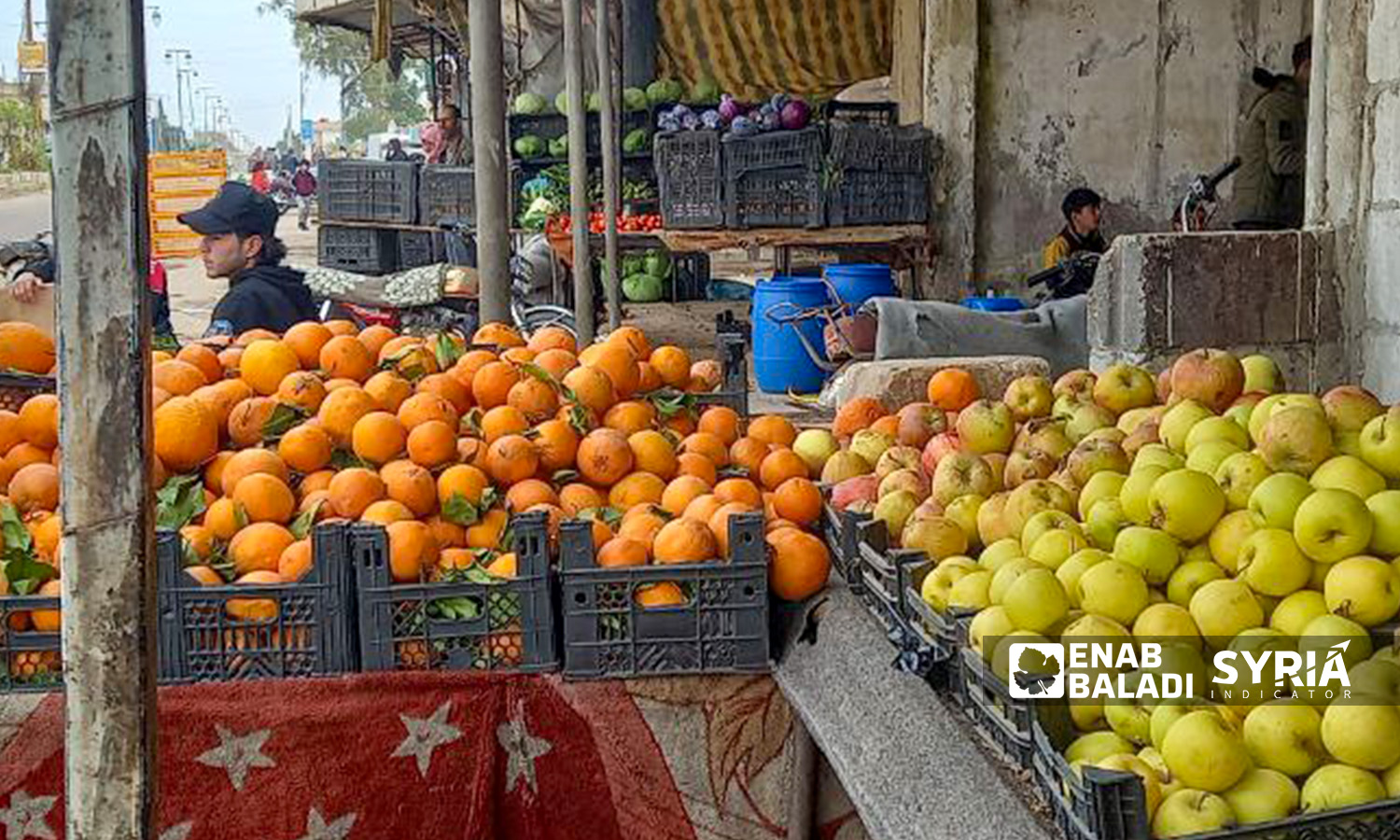
One of the fruit and vegetable stores in the town of Tel Shihab in the western countryside of Daraa governorate – November 8, 2024 (Exclusive for the investigation by Halim Muhammad)
Statistics obtained by the investigation team from regime government documents and open sources (civil registration records, the Central Bureau of Statistics, studies from the Daraa Statistics Directorate, and the United Nations Population Fund) indicate that the population of Daraa governorate decreased from 1,226,000 in 2010 to 680,000 in 2014, a decline of 464,000 residents.
After the “settlement” in 2018, the population reached 924,626 in 2019, making Daraa that year the highest province in Syria in birth rates, at nearly 40 per thousand, according to estimates from the technical committee in the Central Bureau of Statistics (a government agency), based on an official Syrian report backed by the United Nations Population Fund.
Based on the birth rate and estimates of the population in the previous year, which was 991,611, the population should have increased in 2020. However, the number did not exceed 944,646, which is a shortfall of 16,965 residents compared to the natural growth rate.
The shortfall recurred in 2021, with the estimated population being 966,430, while it should have reached 982,431, a deficit of over 16,000 residents relative to the birth rate.
The aforementioned statistics and figures can be questioned due to the cessation of reliable population census operations by the regime government, but they suggest that the governorate has witnessed negative population growth, the main cause of which cannot be firmly established, while the data on the ground prove the continued demographic hemorrhage due to economic and security pressures.
The investigation sought to verify the existence of a second wave of migration, its causes, and nature, through observation and questioning of local parties concerned.
In Muzayrib, which has seen the drying up of its famous lake and most of its springs, two unnamed sources, one a civil registry employee in the governorate and the other a local dignitary named Abu Mu’adh al-Zaraq, mentioned that the population has decreased by half since 2011 and that there is ongoing movement, migration, and displacement. However, the vast majority of those leaving are young individuals.
A third source from local leaders in western Daraa indicated that the migration rate from the area ranged between 40% and 50% of the total population over the years following 2011.
Al-Zaraq noted that the drought of irrigation water has increased unemployment rates in rural Daraa and contributed significantly to the migration of youth in search of job opportunities either in European countries or the Gulf states, without overlooking other reasons such as poor security conditions, cases of assassination, and avoidance of military service.
Al-Zaraq added that the water shortage has led to the drying up of many farm trees, prompting their owners to sell them as firewood, and after losing the main source of income, which is agriculture, “thinking about migration has become an inevitable reality.”
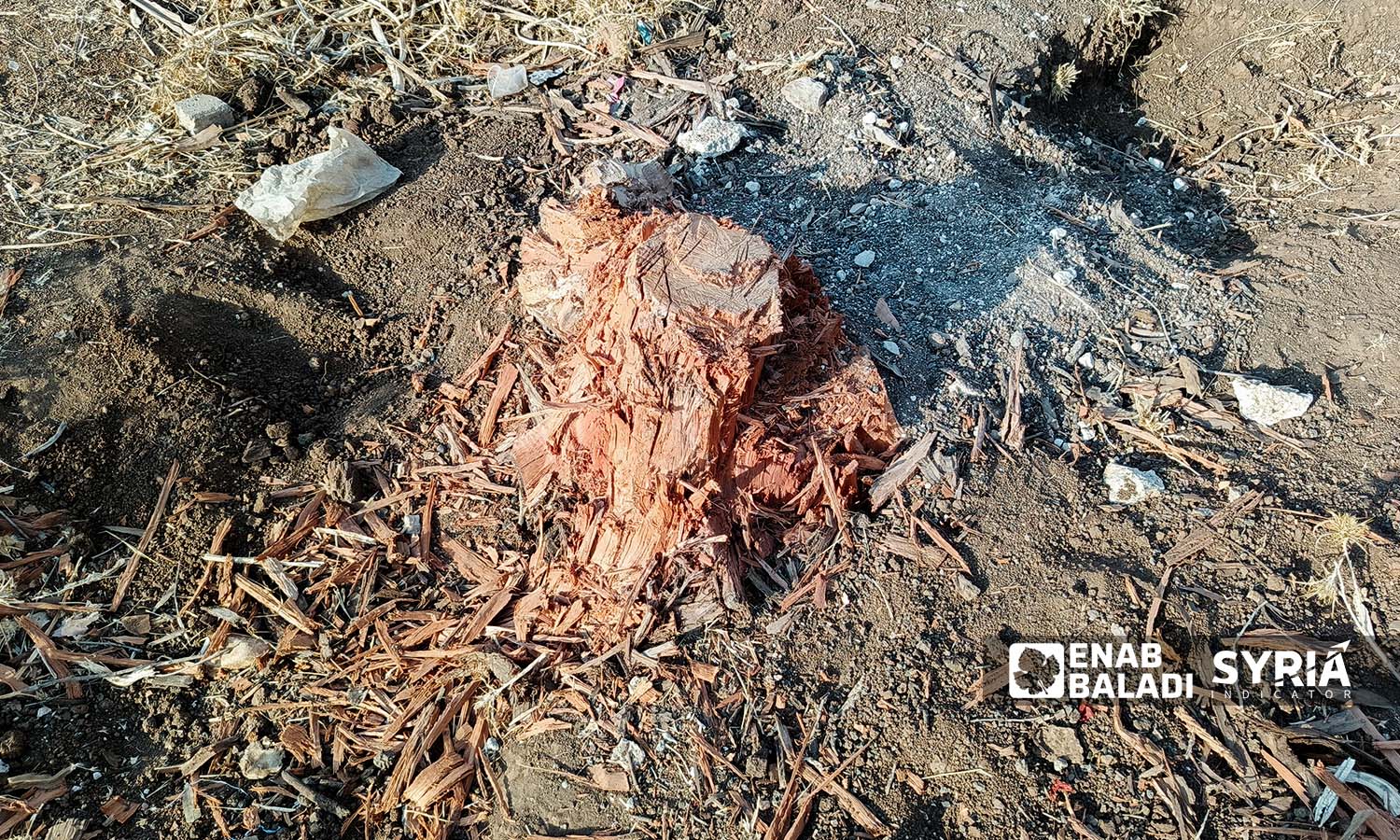
One of the trees cut down for use as firewood – November 8, 2024 (Exclusive for the investigation by Halim Muhammad)
A report titled “From Fields to Fleeing: How Climate Change is Uprooting Syrian Farmers in Daraa Governorate” published by the United Nations website in March 2024 addressed drought and climate change, recounting how farmers witnessed well drying and agricultural decline, which led to decreased job opportunities and increased unemployment.
The report pointed to the departure of 1,000 families from the al-Rabat area southwest of the city of Daraa, where they reside, due to drought, leaving only a few poor families remaining in the region.
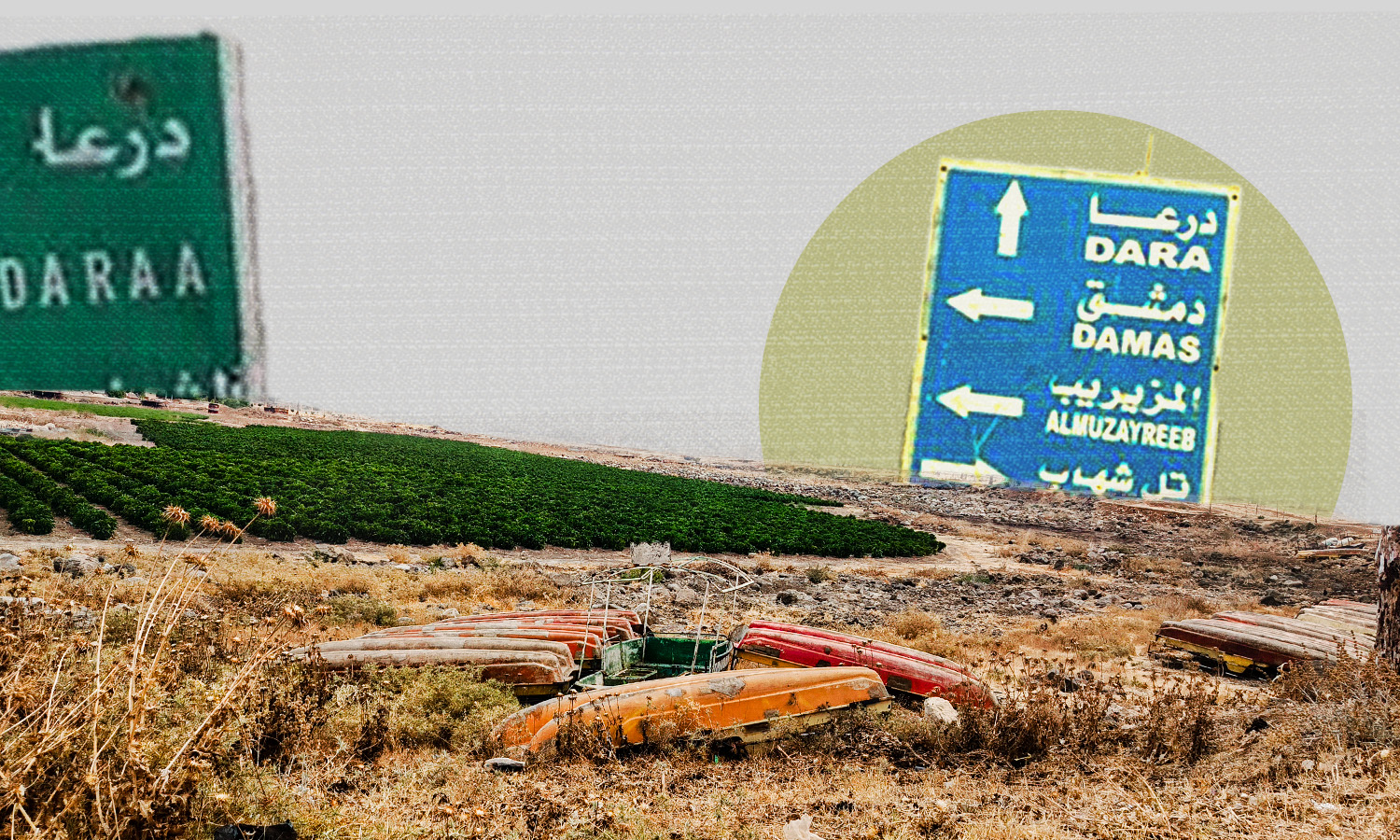
Drought and random well drilling have led to a decline in agricultural activity and an increase in migration from Daraa governorate
Towards Europe and the paths of death
“Venturing into the sea is a big risk, but the difficult situation pushes me to take this chance,” said Youssef H., revealing his intention to migrate.
The thirty-something man owns 10 dunams planted with pomegranate trees, which no longer “bring in their worth,” as he describes it, and is seriously thinking about traveling to one of the European Union countries via Libya, using perilous irregular routes (smuggling routes), driven by the spread of drought across wider areas in rural Daraa, as he told Enab Baladi / Syria Indicator.
Youssef expresses fears about “smugglers” and “gangs” that kidnap migrants and demand ransom from their families.
Similarly, farmer Hussein plans to migrate to Europe after his pomegranate crop deteriorated this season due to the drying up of irrigation water in August, resulting in the loss of his crop planted on 25 dunams, of which he could only water five.
Youssef had not considered migration before, but the drought of irrigation water and the absence of options left him with no choice but to pursue this path to support his family after migrating by sending financial remittances.
The human resource hemorrhage from Daraa continues, as local networks documented on August 31, 2024, the loss of communication with 19 migrants from the city of Tafas in western Daraa in Libya, including children and women identified by name, after they were on a boat that set sail from the Libyan coasts.
The largest incident occurred in June 2023 when dozens of Daraa residents drowned when an old fishing vessel sank off the Greek coast, carrying about 750 people, after departing from the Libyan port of Tobruk.
Humanitarian organizations document more cases of death, disappearance, and loss of communication with migrants from Daraa who have taken the deadly routes, whether by sea or land, including children and women.
Lebanon was the first stop for most migrants from Daraa before the outbreak of the war that this country has witnessed since late September 2024, with migrants traversing either official crossings or smuggling routes.
In addition to economic conditions and drought, security chaos and compulsory military service are primary motivations for the migration of residents in the governorate, especially among the youth.
Those wanted for questioning, absentees from military service, and defectors from the army use smuggling routes to Lebanon after paying about 300 US dollars, from where passports are issued for them at a cost of approximately 2,000 dollars. They then move on to Libya, Cyprus, or Serbia, until they reach their final refugee destination.
Witnesses told the investigation team that some manage to travel to Gulf countries or even to northern Syria, hoping to reach Turkey via smuggling.
Community and organizational efforts
Residents of Daraa complain about the government’s shortcomings in securing drinking and irrigation water, as well as controlling violations due to the spread of nepotism or “corruption.” Witnesses confirmed this, with one noting that the phenomenon of illegal well drilling dates back to before 2011 but has worsened since then due to security chaos.
Farmer Hussein struggled to secure a water source, having drilled four wells costing him nearly half a billion Syrian pounds (over $33,000) without obtaining any water from them. Previously, he used to draw water from al-Sakhina springs, which completely dried up two years ago. He also attempted to buy water from some farmers, but the low water levels made that impossible.
The government resorted to some emergency solutions in the governorate, such as drilling wells in the town of Khirbet Ghazaleh to irrigate Daraa city in early August 2024, after the decline of al-Ashari springs.
They undertook the drilling and restoration of wells to supply various rural areas in the governorate, but relied on donations from residents.
Over the past seven years, the local community launched initiatives that collected tens of billions of Syrian pounds to restore wells, but those efforts were insufficient, given the deteriorating water supply lines and storage reservoirs, which require significant amounts of money that the residents cannot afford, according to H. al-Mikdad, one of those who managed local initiatives to drill two wells to secure drinking water in eastern rural areas of the governorate.
In an example of community success, the residents of the town of Nahta in eastern Daraa drilled and restored 12 wells in the town at their own expense, achieving self-sufficiency in drinking water, according to residents interviewed by Enab Baladi.
Some residents worked to dig wells around their homes to secure drinking water or collaborated to dig a shared well for several homes, supplying it with solar energy as an alternative to the rarely available electricity.
Meanwhile, most areas in Daraa still rely on purchasing water from mobile tankers that are not subject to good regulatory standards, with the price per cubic meter of water ranging between 20,000 and 30,000 Syrian pounds (between $1.5 and $2).
The price of a water tanker is high compared to the economic and living situation, as a laborer earns 6,000 Syrian pounds per hour while working in agriculture, while the minimum government salary is 279,000 Syrian pounds (less than $19).
The cost of drilling one meter is 300,000 Syrian pounds ($20), and some well drilling reaches depths of over 500 meters, as happened in Busra al-Sham, where drilling a well costs nearly $10,000 without considering additional tools such as pumps, and accompanying electrical equipment, which doubles the cost of drilling.
International organizations, in cooperation with the relevant directorates, have completed several projects in rural Daraa, but these do not meet the residents’ needs for drinking and irrigation water.
In June 2024, the World Food Programme (WFP) rehabilitated a project to draw water from the Yarmouk River to irrigate and water adjacent fields; however, the decrease in the river’s water level prevented the operation of the qualified pumps, leading to no benefit for farmers in the summer. The same organization also rehabilitated the Ayn al-Abd Spring, although it has completely dried up.

International organization projects are hindered by drought – November 2024 (Exclusive for the investigation by Halim Muhammad)
In collaboration with the Daraa Water Directorate, UNICEF implemented a project in June to lay polyethylene pipes from the Oyoun al-Sakhina Springs to the town of Tel Shihab, stretching nearly 7 kilometers, after numerous violations damaged the old pipeline supplying the town. However, the project did not take off after the early drying of the springs in July 2024.
Heading towards the worst… Are there solutions?
“There are no solutions to the drought crisis in Daraa in the foreseeable future, and the danger lies in reaching a stage of water scarcity. The drying of the major and minor al-Sakhina springs is a dangerous indicator of the region entering a stage of complete drought,”
Ali al-Buqairat, former head of pumping centers in the Yarmouk Basin.
There are 16 dams in Daraa, some of which are out of service, and most need maintenance and restoration, such as the Daraa dam, which has been out of service since 2011, and the Sheikh Maskin dam. Engineer Khaled al-Hashish, who works in the Water Directorate, confirmed to the investigative team that the dams could help cover part of the shortage in light of drought, but they lack maintenance and rehabilitation, while the functional ones suffer from poor administration and inequitable distribution.
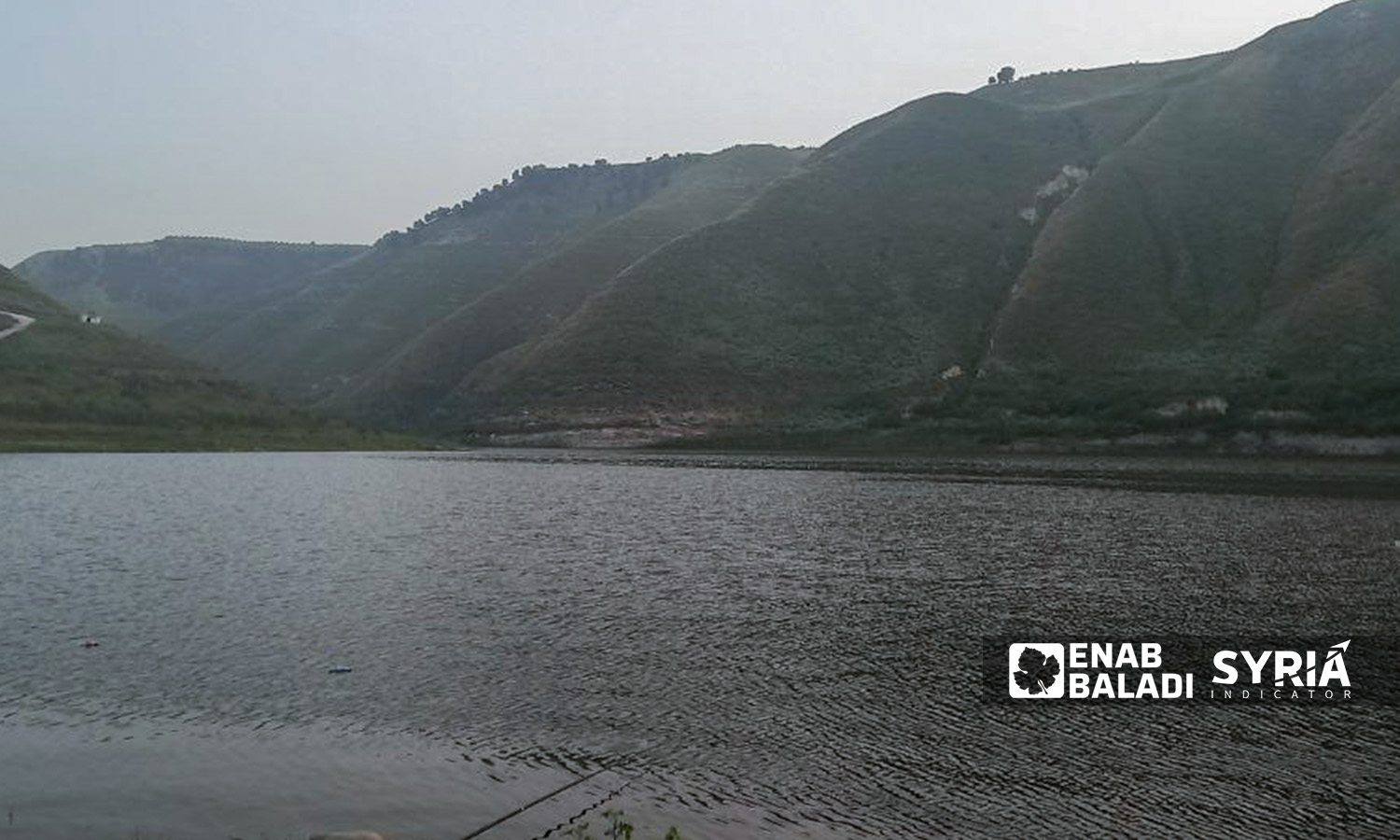
The al-Wahda dam in the Yarmouk Valley on the border between Syria and Jordan – July 2024 (Exclusive for the investigation by Halim Muhammad)
Al-Hashish emphasizes the importance of these dams in storing water during the winter for use in summer agricultural projects.
The situation is no different in other areas of Syria, but Daraa remains one of the most sensitive regions to the effects of drought and mismanagement of water resources, given its location in rain-poor areas.
The Syrian government must take effective steps to address the water crisis in the country as a whole, according to agricultural engineer Jalal al-Attar, who specializes in agricultural scientific research.
In an article on the Carnegie Center website, al-Attar proposed several suggestions to overcome the crisis in Syria, including:
- Improving infrastructure and developing sustainable and smart urban planning to enhance adaptation efforts to climate change.
- Improving water resource management.
- Enhancing sustainability in water use by implementing modern irrigation systems.
- Promoting sustainable agriculture and encouraging the cultivation of climate-adapted crops that consume less water.
- Increasing community capacity to adapt by raising awareness of the dangers of climate change.
- Enhancing international cooperation with neighboring countries to share water resources and rely on renewable energy sources.
A study states that the recent drought wave that began in 1998 in Syria and the Eastern Mediterranean may be the worst in nearly 900 years. Drought expert Colin Kelley, who authored previous research on the region, mentions that predictions lean toward continuing drought throughout the next century.
Climate Central reports that what is happening in the region now could be just the beginning of a longer and more severe drought, and water scarcity and conflicts could lead to increased tensions.
Investigation: Ali Eid – Hassan Ibrahim
Contribution: Daraa’s correspondent Halim Muhammad
Visual support: Yousef Humms
Translation: Olaa Soulaiman
if you think the article contain wrong information or you have additional details Send Correction
النسخة العربية من المقال
-
Follow us :













 Drought and random well drilling have led to a decline in agricultural activity and an increase in migration from Daraa governorate
Drought and random well drilling have led to a decline in agricultural activity and an increase in migration from Daraa governorate





 A
A
A
A
A
A

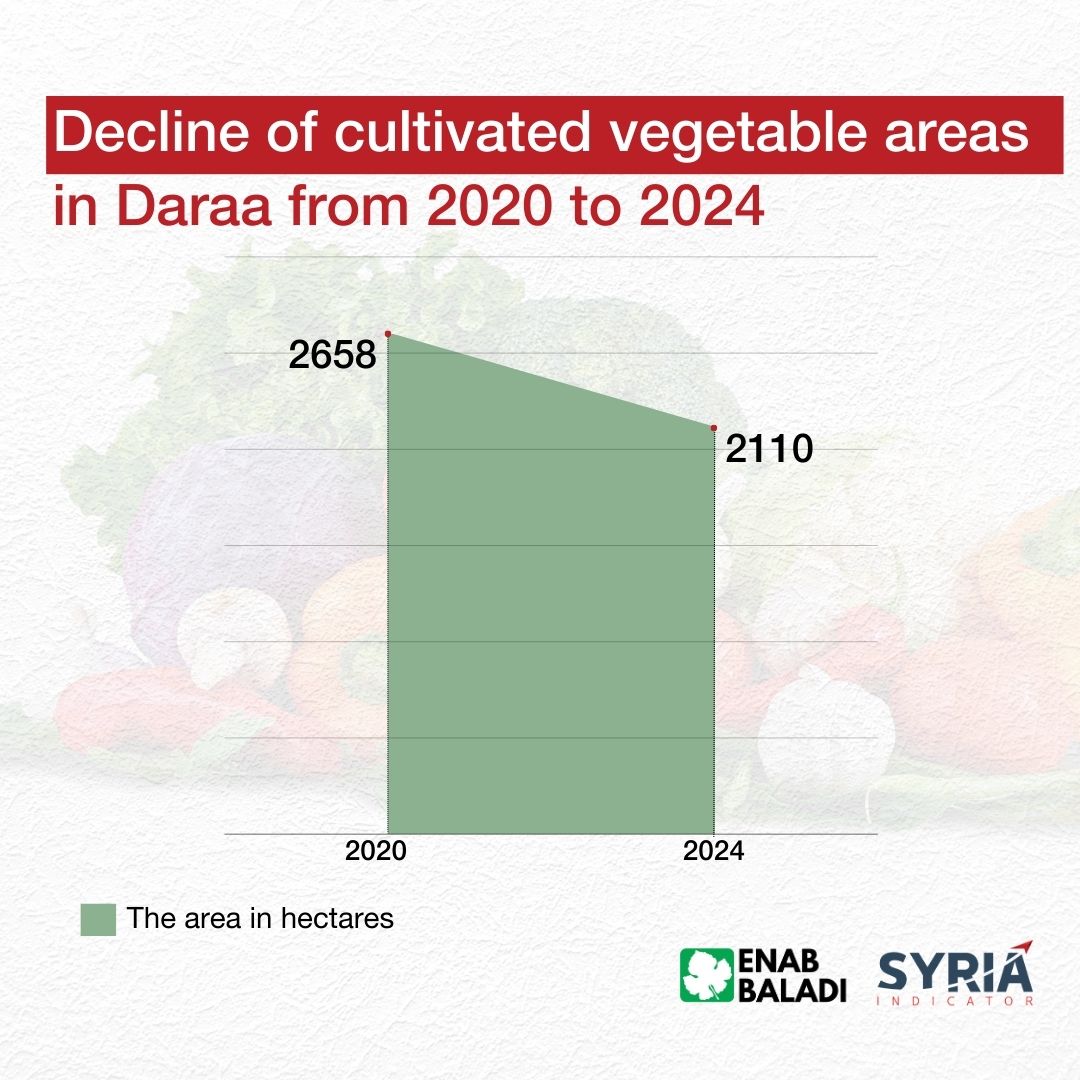

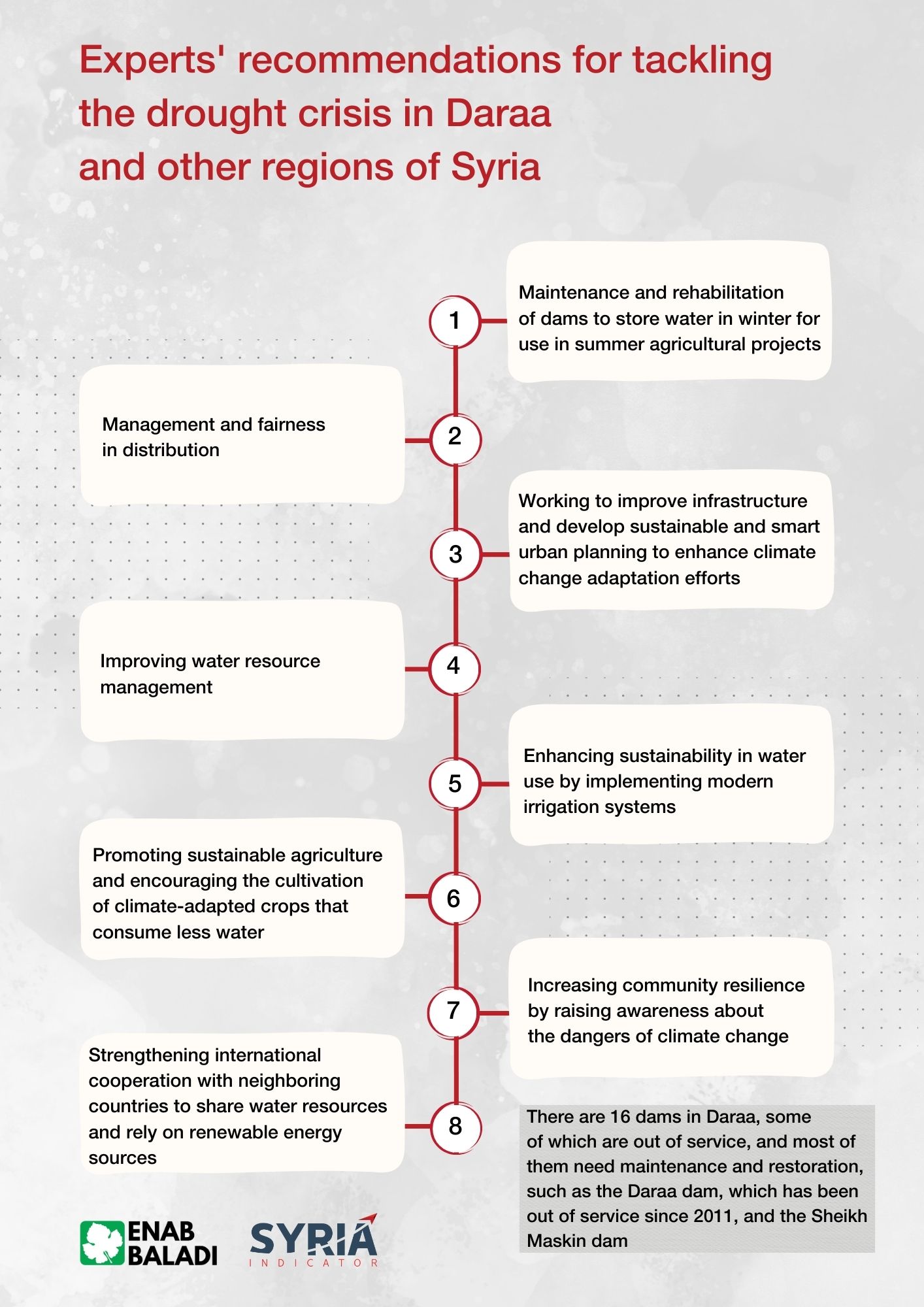


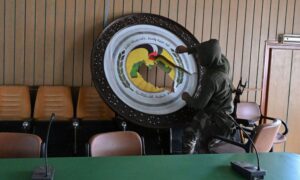
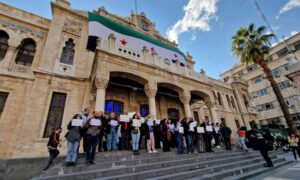
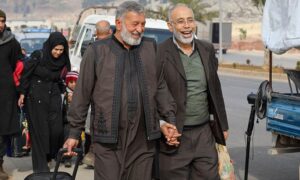


 More In-Depth
More In-Depth